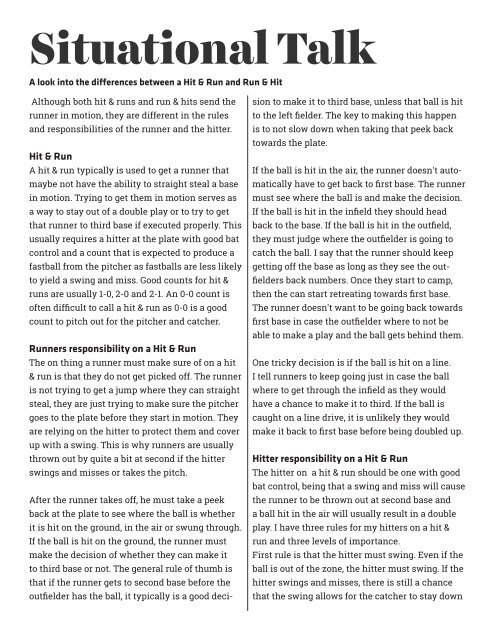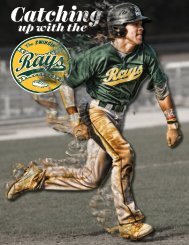Swingin' Rays Volume 1
Create successful ePaper yourself
Turn your PDF publications into a flip-book with our unique Google optimized e-Paper software.
Situational Talk<br />
A look into the differences between a Hit & Run and Run & Hit<br />
Although both hit & runs and run & hits send the<br />
runner in motion, they are different in the rules<br />
and responsibilities of the runner and the hitter.<br />
Hit & Run<br />
A hit & run typically is used to get a runner that<br />
maybe not have the ability to straight steal a base<br />
in motion. Trying to get them in motion serves as<br />
a way to stay out of a double play or to try to get<br />
that runner to third base if executed properly. This<br />
usually requires a hitter at the plate with good bat<br />
control and a count that is expected to produce a<br />
fastball from the pitcher as fastballs are less likely<br />
to yield a swing and miss. Good counts for hit &<br />
runs are usually 1-0, 2-0 and 2-1. An 0-0 count is<br />
often difficult to call a hit & run as 0-0 is a good<br />
count to pitch out for the pitcher and catcher.<br />
Runners responsibility on a Hit & Run<br />
The on thing a runner must make sure of on a hit<br />
& run is that they do not get picked off. The runner<br />
is not trying to get a jump where they can straight<br />
steal, they are just trying to make sure the pitcher<br />
goes to the plate before they start in motion. They<br />
are relying on the hitter to protect them and cover<br />
up with a swing. This is why runners are usually<br />
thrown out by quite a bit at second if the hitter<br />
swings and misses or takes the pitch.<br />
After the runner takes off, he must take a peek<br />
back at the plate to see where the ball is whether<br />
it is hit on the ground, in the air or swung through.<br />
If the ball is hit on the ground, the runner must<br />
make the decision of whether they can make it<br />
to third base or not. The general rule of thumb is<br />
that if the runner gets to second base before the<br />
outfielder has the ball, it typically is a good decision<br />
to make it to third base, unless that ball is hit<br />
to the left fielder. The key to making this happen<br />
is to not slow down when taking that peek back<br />
towards the plate.<br />
If the ball is hit in the air, the runner doesn't automatically<br />
have to get back to first base. The runner<br />
must see where the ball is and make the decision.<br />
If the ball is hit in the infield they should head<br />
back to the base. If the ball is hit in the outfield,<br />
they must judge where the outfielder is going to<br />
catch the ball. I say that the runner should keep<br />
getting off the base as long as they see the outfielders<br />
back numbers. Once they start to camp,<br />
then the can start retreating towards first base.<br />
The runner doesn't want to be going back towards<br />
first base in case the outfielder where to not be<br />
able to make a play and the ball gets behind them.<br />
One tricky decision is if the ball is hit on a line.<br />
I tell runners to keep going just in case the ball<br />
where to get through the infield as they would<br />
have a chance to make it to third. If the ball is<br />
caught on a line drive, it is unlikely they would<br />
make it back to first base before being doubled up.<br />
Hitter responsibility on a Hit & Run<br />
The hitter on a hit & run should be one with good<br />
bat control, being that a swing and miss will cause<br />
the runner to be thrown out at second base and<br />
a ball hit in the air will usually result in a double<br />
play. I have three rules for my hitters on a hit &<br />
run and three levels of importance.<br />
First rule is that the hitter must swing. Even if the<br />
ball is out of the zone, the hitter must swing. If the<br />
hitter swings and misses, there is still a chance<br />
that the swing allows for the catcher to stay down




